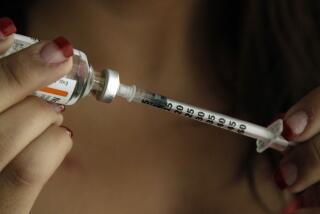Virus Role in Some Diabetes Believed Found
- Share via
UCLA researchers believe they have solved the mystery of how viruses can cause insulin-dependent diabetes, a condition affecting nearly 1 million Americans in which the body’s cells are unable to process sugar properly.
UCLA biologist Allan J. Tobin will report today at the International Diabetes Federations Congress in Washington, D.C., that he has identified the mechanism by which the body’s immune system attacks the insulin secreting cells of the pancreas, triggering insulin-dependent diabetes.
The discovery, Tobin said, may lead to ways to prevent the development of diabetes through early detection and drug intervention.
“This is an extremely interesting development,” said biochemist Joan Harmon, executive director of the Diabetes Research Program at the National Institutes of Health. “It doesn’t quite prove that the . . . virus is the culprit, but it’s very suggestive evidence.”
“It certainly lends further support to the belief that a viral infection triggers an autoimmune response against the pancreas,” said Richard Kahn, chief executive and medical officer of the American Diabetes Assn. “It does seem like the most obvious mechanism.”
Immediate symptoms of insulin-dependent diabetes can be controlled by injecting insulin two to four times a day. Despite that treatment, many diabetics eventually develop blindness, kidney damage that may require a transplant, and peripheral nerve damage that can lead to amputation of limbs.
Because of these problems, physicians want to prevent diabetes before damage to the pancreas becomes severe.
Tobin’s team has found that a protein in a family of viruses--called Coxsackie viruses--that cause respiratory infections bears a remarkable resemblance to a human protein that is attacked in the first stages of diabetes.
Tobin and his colleagues believe that when a person at risk for insulin-dependent diabetes is infected with a Coxsackie virus, the person’s immune system “is fooled” and destroys the pancreas’ insulin-producing “beta” cells.
“This leads to (insulin-dependent) diabetes,” Tobin said, “because, once the beta cells are gone, the person cannot make insulin,” which regulates the use of sugar by cells throughout the body.
The protein Tobin is studying is called glutamic acid decarboxylase or GAD. Research by pathologists Mark Atkinson and Noel Maclaren of the University of Florida shows that antibodies against GAD are present in the blood as long as seven years before the symptoms of insulin-dependent diabetes begin.
The Florida researchers and others are screening close relatives of diabetics in a search for individuals who have the antibodies, making them likely to develop insulin-dependent diabetes. Once these individuals are identified, the researchers are administering immune-suppressing drugs in an attempt to stave off the onset of diabetes for at least a few years. Eventually, when more selective immunosuppressive drugs are developed, they hope to block the process completely.
Atkinson and Maclaren studied the antibodies against GAD for many years without knowing the identity of the protein against which the antibodies were directed. All they knew was that a certain type of antibody was present long before diabetes began. It was only last September that microbiologist Steinunn Baekkeskov of UC San Francisco found that the antibodies were directed against GAD, a protein found in both the beta cells of the pancreas and in the brain.
Tobin, who had been studying GAD because of its potential links to epilepsy, began comparing its structure to those of all known proteins. “The protein that has the strongest resemblance to GAD is a segment of a protein from a virus called Coxsackie virus--a common respiratory virus related to polio,” he said
This finding represented the first strong physical link of diabetes to a virus. That confirmation has opened the door to possibly preventing or mitigating this type of viral infection, Tobin said.
Some researchers, especially epidemiologists D. Robert Gamble of West Park Hospital in Epsom, England, and K. W. Taylor of the University of Sussex in Brighton, have previously demonstrated epidemiological links between Coxsackie viruses and diabetes. But such links are particularly difficult to prove because diabetes can develop so long after the infection.
The confirmation that autoimmunity is involved in diabetes, Tobin said, “will be useful in three ways.” It will:
* Make it easier to differentiate between insulin-dependent diabetes and non-insulin dependent diabetes, which affects more than 9 million Americans, but whose symptoms are not as severe and which does not require insulin injections.
* Allow the identification of individuals in which pancreas destruction has already begun and who are thus good candidates for therapy.
* Eventually make possible the screening of the whole population to identify people who will become diabetic but have not yet developed symptoms.
Tobin also said that the discovery will give insight into why some diabetics develop nerve disorders called neuropathies. Those neuropathies could be caused by attacks against GAD in nerve cells.
Most diabetics who have had the disease for several years no longer have antibodies against GAD, he said. But in nine patients they studied who had neuropathies, all had persistent high levels of the antibodies, indicating that the destructive process was ongoing. Tests for antibodies could thus lead to predictions of which diabetics are most likely to suffer neuropathies.






